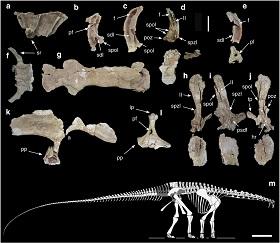River subbasins more depleted than
official figures show
09 April 2024
Published online 23 July 2013

The fossil remains of a previously unknown species of sauropod dinosaur, Tataouinea hannibalis were recently unearthed in southern Tunisia. Sauropods were huge herbivores with a long tail and neck, but a small head. The species is presented in the journal Nature Communications.
In 2011, after two years of digging at depths originating from the Cretaceous period, about 136 million years ago, the University of Bologna and the Office National des Mines in Tunis found the most complete remains of a dinosaur yet found in northern Africa.
A large opening found in the ischium, which opens into a large air chamber, supports the theory that these dinosaurs had abdominal air sacs— strong evidence for an avian-like respiratory system.
As with birds, it appears the bones of Tataouinea were hollow, making it light weight for its estimated 14 metre long body.
Tataouinea is more closely related to the Iberian Demandasaurus than other African and South American dinosaurs. This supports the theory that rebbachisaurids, a family of sauropod dinosaurs, originated in the south then spread up to Europe.
doi:10.1038/nmiddleeast.2013.107
Stay connected: